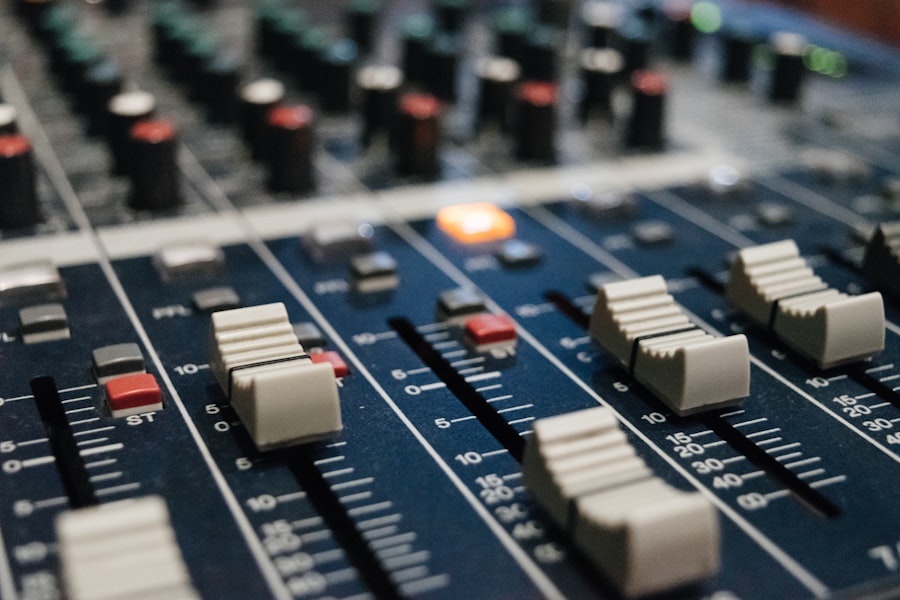Audio MADI (Multichannel Audio Digital Interface) over the Internet represents a significant evolution in the way audio is transmitted and managed in professional settings. Traditionally, MADI has been a robust standard for transmitting high-quality audio signals over coaxial or optical cables, allowing for the transfer of multiple channels of audio data with minimal latency.
This shift not only facilitates long-distance audio communication but also opens up new avenues for creativity and collaboration in the music and broadcasting industries. The concept of Audio MADI over the Internet leverages existing network infrastructure to transport audio signals, enabling users to connect devices that are geographically dispersed. This technology is particularly beneficial in scenarios such as live event broadcasting, remote recording sessions, and collaborative music production.
By utilizing the Internet, audio professionals can bypass the limitations of physical cabling, allowing for greater flexibility in their setups. As the technology continues to evolve, understanding its intricacies and applications becomes essential for those looking to harness its full potential.
Key Takeaways
- Audio Madi Over Internet allows for the transmission of high-quality audio signals over the internet, providing a cost-effective and flexible solution for audio professionals.
- The benefits of using Audio Madi Over Internet include increased flexibility, reduced costs, and the ability to easily integrate with existing audio systems.
- Challenges of using Audio Madi Over Internet include potential latency issues, network reliability, and the need for high-speed internet connections.
- Setting up Audio Madi Over Internet involves connecting Madi-enabled devices to a network, configuring audio routing, and ensuring proper network settings.
- Tips for ensuring quality Audio Madi Over Internet include using high-quality networking equipment, optimizing network performance, and implementing redundancy measures to minimize potential issues.
The Benefits of Using Audio Madi Over Internet
One of the primary advantages of using Audio MADI over the Internet is the ability to transmit high-quality audio over long distances without the degradation typically associated with traditional cabling methods. MADI supports up to 64 channels of audio at 24-bit resolution and 96 kHz sample rates, making it an ideal choice for professional audio applications. When transmitted over the Internet, these high-quality signals can be maintained, allowing for pristine audio fidelity that is crucial in professional settings such as recording studios and live sound environments.
Additionally, the flexibility offered by Audio MADI over the Internet cannot be overstated. With traditional MADI setups, physical limitations often dictate how equipment can be arranged and connected.
This capability is particularly advantageous for remote collaborations, where musicians or sound engineers can work together in real-time from different parts of the world. The ability to connect multiple locations seamlessly enhances creativity and productivity, enabling teams to produce high-quality audio content without being constrained by geographical barriers.
The Challenges of Using Audio Madi Over Internet

Despite its numerous benefits, implementing Audio MADI over the Internet is not without its challenges. One significant concern is latency, which can affect the timing and synchronization of audio signals. While MADI itself is designed for low-latency transmission, routing these signals over the Internet introduces potential delays due to network congestion, packet loss, or varying transmission speeds.
This latency can be particularly problematic in live performance situations where real-time interaction is essential. Audio engineers must carefully consider their network configurations and choose appropriate hardware to minimize these delays. Another challenge lies in ensuring reliable connectivity.
The quality of an Internet connection can vary significantly based on factors such as bandwidth availability, network traffic, and infrastructure quality. Inconsistent connections can lead to interruptions or dropouts in audio transmission, which can be detrimental in professional settings. To mitigate these risks, users must invest in robust networking equipment and consider implementing redundancy measures to ensure continuous operation even in the event of a network failure.
How to Set Up Audio Madi Over Internet
| Step | Description |
|---|---|
| 1 | Ensure you have a stable and high-speed internet connection. |
| 2 | Acquire MADI-compatible audio equipment and interfaces. |
| 3 | Set up MADI audio interfaces to connect to your computer or network. |
| 4 | Configure MADI audio settings for streaming over the internet. |
| 5 | Test the audio MADI setup for stability and quality. |
Setting up Audio MADI over the Internet requires a combination of hardware and software components designed to facilitate the transmission of audio signals across networks. The first step involves selecting appropriate MADI interfaces that are capable of converting MADI signals into a format suitable for Internet transmission. Many modern audio interfaces come equipped with built-in Ethernet ports that support various streaming protocols, making them ideal for this purpose.
Once the hardware is in place, configuring the network settings is crucial for successful transmission. This includes assigning static IP addresses to devices involved in the setup and ensuring that Quality of Service (QoS) settings are optimized for audio traffic. QoS prioritizes audio packets over other types of data on the network, reducing the likelihood of latency or dropouts during transmission.
Additionally, users should consider employing Virtual Private Networks (VPNs) to create secure connections between remote locations, further enhancing reliability and security.
Tips for Ensuring Quality Audio Madi Over Internet
To achieve optimal audio quality when using MADI over the Internet, several best practices should be followed. First and foremost, it is essential to ensure that all devices involved in the transmission are equipped with high-quality components capable of handling the demands of professional audio. This includes using high-grade cables and connectors that minimize signal loss and interference.
Moreover, monitoring network performance is critical for maintaining audio quality. Tools such as network analyzers can help identify potential bottlenecks or issues within the network that may affect audio transmission. Regularly testing bandwidth and latency can provide valuable insights into network health and allow users to make necessary adjustments before critical sessions or performances.
Additionally, employing error correction protocols can help mitigate issues related to packet loss, ensuring a more stable audio stream.
Security Considerations for Audio Madi Over Internet

As with any technology that relies on Internet connectivity, security is a paramount concern when implementing Audio MADI over the Internet. The transmission of audio data across public networks exposes it to potential interception or unauthorized access. To safeguard against these risks, it is essential to implement robust security measures.
One effective strategy is to utilize encryption protocols such as Secure Real-time Transport Protocol (SRTP) or Transport Layer Security (TLS) to protect audio streams during transmission. These protocols encrypt data packets, making it significantly more difficult for malicious actors to intercept or manipulate audio signals. Additionally, employing firewalls and intrusion detection systems can help monitor network traffic and prevent unauthorized access attempts.
Regularly updating software and firmware on all devices involved in the setup is also crucial for maintaining security. Manufacturers often release updates that address vulnerabilities or improve performance, so staying current with these updates can help protect against potential threats.
Case Studies: Successful Implementation of Audio Madi Over Internet
Several organizations have successfully implemented Audio MADI over the Internet, showcasing its potential in various applications. One notable example is a major broadcasting company that utilized this technology to facilitate remote live broadcasts from multiple locations during a large-scale event. By connecting their central studio with remote production units via MADI over the Internet, they were able to achieve seamless audio integration without the need for extensive cabling or on-site personnel.
Another case study involves a renowned music production team that adopted Audio MADI over the Internet for collaborative projects with artists located around the globe. By setting up a virtual studio environment where musicians could connect their instruments and recording equipment directly to a centralized mixing console via MADI over IP, they were able to produce high-quality tracks without geographical constraints. This innovative approach not only streamlined their workflow but also fostered creative collaborations that would have been logistically challenging under traditional setups.
The Future of Audio Madi Over Internet
The future of Audio MADI over the Internet appears promising as advancements in technology continue to enhance its capabilities and applications. As more professionals recognize the benefits of remote collaboration and flexible audio routing, the demand for reliable solutions will likely grow. Innovations in networking technology, such as 5G connectivity and improved compression algorithms, will further facilitate high-quality audio transmission over long distances.
Moreover, as industries adapt to changing work environments—such as remote work becoming more commonplace—the integration of Audio MADI over the Internet will play a crucial role in shaping how audio professionals operate. By embracing this technology, users can unlock new creative possibilities while overcoming traditional limitations associated with physical setups. As we move forward into an increasingly interconnected world, Audio MADI over the Internet stands poised to redefine how we approach audio production and collaboration on a global scale.
FAQs
What is MADI (Multichannel Audio Digital Interface)?
MADI is a digital audio interface that allows for the transmission of multiple channels of audio over a single cable. It is commonly used in professional audio applications such as live sound, recording studios, and broadcast.
Can MADI be used over the internet?
Yes, MADI can be used over the internet with the use of appropriate networking equipment and protocols. However, it is important to consider factors such as latency, bandwidth, and network reliability when using MADI over the internet.
What are the considerations when using MADI over the internet?
When using MADI over the internet, it is important to consider factors such as latency, bandwidth, and network reliability. High latency can cause audio delay, while insufficient bandwidth or network instability can result in audio dropouts or loss of signal.
What equipment is needed to use MADI over the internet?
To use MADI over the internet, you will need MADI-compatible audio interfaces, networking equipment such as routers and switches, and potentially specialized MADI-over-IP converters or interfaces. It is also important to have a stable and high-speed internet connection.
What are the benefits of using MADI over the internet?
Using MADI over the internet can allow for the transmission of high-quality, multichannel audio over long distances without the need for physical cabling. This can be particularly useful for remote recording, live streaming, and distributed audio systems.

